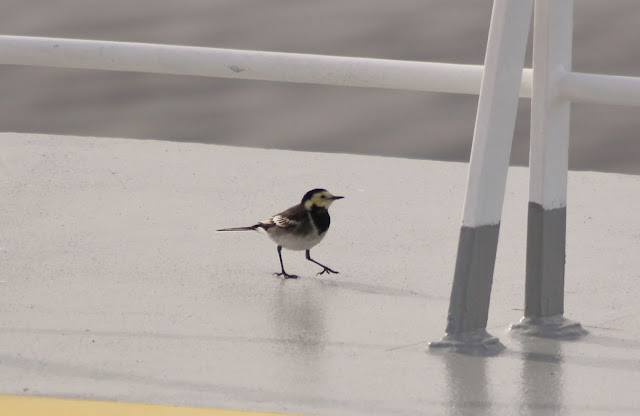In addition
to seabirds and marine mammals, we also record the various types of terrestrial
migrants which can be seen around the ship. In the height of autumn, millions
(if not billions) of birds across the Northern Hemisphere are making their way
south for the winter. Some species might be travelling all the way from the High
Arctic to Africa while others might be making shorter journeys from Scandinavia
to Britain and Ireland. Either way, most have to make water crossings at some
stage and we are likely to encounter some of these in the Celtic Sea during
October surveys.
Song thrush (c) Meadhbh Quinn
Easterly
winds have been in place for much of the month, bringing a wide range of rare
and interesting species to migration hotspots (e.g. islands and coastal
headlands) along Western Europe. These winds have also guided many birds out to
sea and over the past couple of weeks we’ve recorded seventeen species of
migrant landbird either flying around or on the ship; collared dove, skylark,
swallow, meadow pipit, white wagtail (and pied wagtail), grey wagtail, robin,
song thrush, redwing, fieldfare, blackcap, chiffchaff, yellow-browed warbler,
goldcrest, starling, chaffinch and goldfinch. During bright, sunny days and
clear conditions, most of these birds simply fly over or around the ship,
perhaps reorientating themselves before continuing on with their journey. Some
rain overnight and misty conditions has resulted in several birds actually
landing on the ship this morning. None have been found dead so hopefully all
they require is a rest before carrying on again once the weather clears up.
Starling (c) Niall T. Keogh
A merlin was
seen in flight at sea one day last week over active fishing grounds with
several trawlers in operation. It would be easy to assume that they too have
been blown off course or are in the midst of an active water crossing but I
suspect that these falcons are out here on purpose, travelling from ship to
ship in search of tired migrant songbirds to catch or using them as a platform
from which to hunt storm-petrels. We have certainly witnessed them catching
meadow pipits on RV Celtic Explorer before and have often found storm-petrel wing feathers here and there on the deck,
looking like they were recently plucked off.
Merlin with a meadow pipit kill. Pic from October 2014 (c) William Hunt
Wildfowl and
waders seen at sea are often noted as being in the throes of migration,
travelling from A to B with great enthusiasm and rarely take an interest in the
ship. A flock of ten European golden plover seen several miles south of Great
Saltee last week looked like they were doing just that, heading for
France/Iberia with intent! A couple of turnstones mixed in with a flying flock
of guillemots looked somewhat more confused however!
One of our
best sightings was that of a single light-bellied brent goose which crossed the
bow, flying east some 19 nautical miles south-southeast of Carnsore Point. Amazing
to think that this bird has just spent the summer on the breeding grounds in
Arctic Canada alongside polar bears, wolves and musk ox and is now off to
Ireland/Britain for the winter where it is likely to end up grazing on football
pitches and golf courses at some stage!
Light-bellied brent goose (c) Niall T. Keogh
For anyone
interested in checking out more records of migrant landbirds at sea then I’d
suggest looking up the North Sea Bird Club website and Facebook page, the #birdsonboat hashtag on Twitter and Kevin Duffy’s pics which he often posts on Twitter from an oil
rig off Shetland.
Male blackcap (c) Niall T. Keogh
Male and female blackcap (c) Niall T. Keogh
Song thrush (c) Meadhbh Quinn
Song thrush (c) Meadhbh Quinn
Chiffchaff (c) Niall T. Keogh
Chiffchaff (c) Meadhbh Quinn
Chiffchaff (c) Meadhbh Quinn
Robin (c) Niall T. Keogh
Collared dove (c) Niall T. Keogh
Pied wagtail on the bow (c) Niall T. Keogh
Swallow (c) Niall T. Keogh
Skylark flying past the ship (c) Niall T. Keogh
Starlings (c) Niall T. Keogh



















































